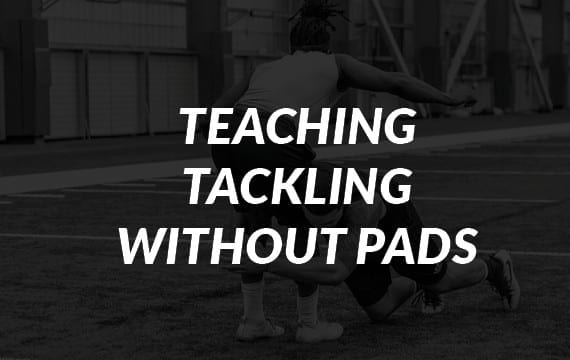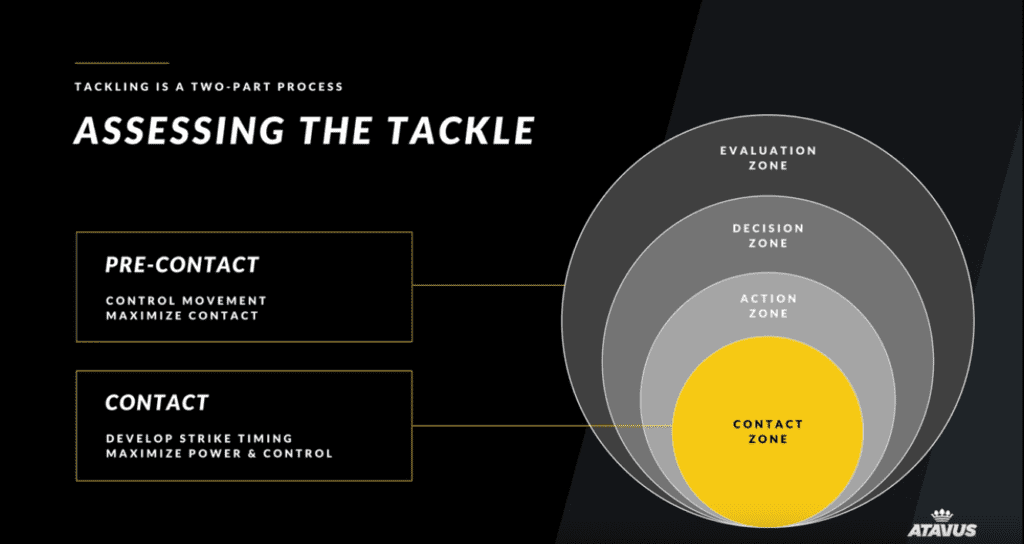| As more and more governing bodies limit the number of full contact practices, coaches need to understand how to make the most of non-contact practices and develop effective tacklers. |

Taylor Kempf, Feb. 13th 2019
Football players took 19 years to realize that pads might be a good idea. From 1869 to 1888, players opted to play pad-free. Fifty-one years after that, the sport introduced helmets to protect the heads of players from inadvertent contact with the ground and each other. Little did players know at the time that they may be setting into action an irreversible dependency on padding to protect players from each other.
Ironically, 150 years after the first college game we are discussing the merits of removing pads in certain instances to increase player safety and reduce contact related concussions and musculoskeletal injuries. Pads are being eliminated from practice fields to encourage better recovery and limit opportunities for injury.
Every major football governing body has strict rules regarding contact during practice and even players wearing pads during said practices. The NCAA, NFL, and CFL all have imposed limitations to when and how much players can contact each other during practice.
Setting Guidelines for Contact
The National Collegiate Athletic Association, the body that oversees all of college athletics including eligibility and competition rules, has set forth strict guidelines for spring practices while presenting several “suggested” guidelines for practice during the regular season.
Amongst these guidelines are policies that determine when contact is allowed in “spring ball”. The policies are quite simple:
1. Only 15 practices will be allowed in the spring period and all must occur within 34 days of the start date.
2. Practices 1 and 2 must be non-contact with a third no-contact practice of the school’s choosing.
3. Only 8 of the remaining 12 contact practices may involve full tackling.
4. Only 3 of the remaining 12 contact practices may have over half of the practice time feature 11-on-11 play.
5. There can be no more than four hours of practice any given day and 20 hours any given week during spring ball.
Spring football is invaluable to college and high-school coaches as it represents an opportunity to evaluate players, provide feedback to be carried into summer individual work, and instill the culture of a program during a time when players may be thinking about things outside of football.
The NCAA has determined that while this period does hold value, it is important to protect the health and safety of players by limiting opportunities for injury. There are multiple factors that could increase the potential for injury during spring football including a limited number of players available and a general lack of conditioning.
In preparation for football season, players have traditionally endured late summer camps that include multiple contact practices in a day known as two-a-days. The NCAA formally recommends the discontinuation of these types of practice behaviors as the incidence of injury during this period is high.
In addition to the elimination of the second practice in a day, the NCAA suggests at least three sessions in a seven-day period be non-contact with a fourth day eliminating practice altogether. This leads to the conclusion that non-contact practices or those held without pads can be considered a player safety initiative.
One might assume that once players have matured both physically and mentally, they might be less vulnerable to practice injuries or that practicing without pads would lose value. In fact, the NFL has instituted new policies regarding limiting practicing in pads at the behest of the players through their Union.
According to the bargaining agreement reached between the NFLPA and the NFL, only 14 padded practices may occur throughout the regular season with 11 of them coming in the first 11 weeks of the season.
Protection of players is a serious business in professional football and so is winning. The NFL understands that there is value in practicing without pads to both improve preparation for the game and keep players safe and healthy enough to participate each week.
The Canadian Football League recently took practice restrictions a step further and eliminated padded practices during the season entirely. Players wear helmets only for the purposes of acclimation and all regular season practices go on without any other equipment.
Teaching Tackling Without Pads
The central value of practicing without pads lies in the enhanced recovery of athletes. Football is unique in that it is played on a weekly basis over a short period of time. Other sports play more frequently but few exhibit the physicality required of football players from high school through professional levels.
The consistent wear and tear on the body of a football athlete is the main concern for proponents of limiting practice contact. Randy Ambrosie, the commissioner of the CFL, believes that eliminating contact during practices between games is better for the players. He insists that players can recover faster without enduring further pounding during practice and says in an ESPN interview, “If it results in one less player injured, it is worthwhile”.

Assessing the tackle with the Atavus Tackle System
Moreover, learning to tackle is more than just hitting somebody as hard as you can. At Atavus, we break the tackle into two parts with contact being the second.
Pre-contact is just as important as contact—some would say *more* important—because of the way the tackler can control movement and maximize contact with the ball carrier. The techniques for maintaining leverage in the pre-contact step do not require pads; they can be taught without contact. (Or with contact, for that matter: the Atavus Tackle System works either way.) It doesn’t matter how hard you can hit if you lose leverage the runner slips past you.
Pads or No Pads?
There are those who adamantly oppose limitations to practicing in pads or contact periods. Most of those campaigning against the new wave of protocols cite the lack of data pointing to improved safety and believe limiting contact in practice is more dangerous.
Those opposing the restrictions are a dying breed, of sorts, as more and more programs at all levels adapt to the reality that practicing without pads is an environment that fosters safer behavior and decreases the strain on athletes’ bodies. And, even if a coach strongly believes that contact in practice is essential, a good chance exists that the decision has already been made by his governing body.
Whether you believe the best way to learn how to tackle is with pads or not, the evidence is strong that players can develop as tacklers without pads. Companies like Atavus are developing technique and practice plans that help coaches make the most of mandated non-contact practices. Understanding this technique and helping your players develop and retain the skills to be an effective tackler is crucial for every coach.